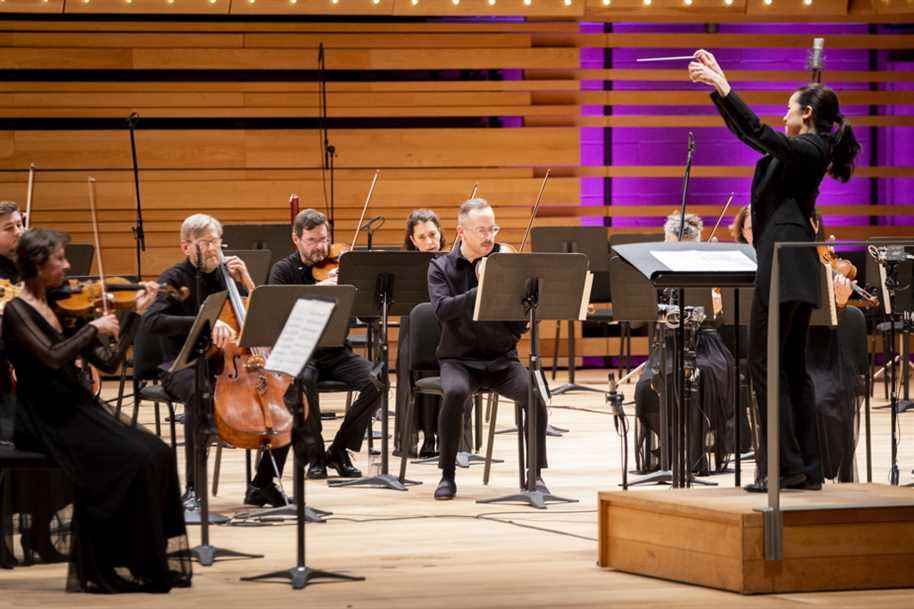The Orchester Métropolitain gave its last autumn concert at the Maison symphonique on Tuesday evening – if we except its participation in the Bach Festival on December 5 – a concert once again placed under the seal of diversity. An evening in tune with the times, the memory of which will however undoubtedly not be unforgettable.
The ensemble was led by a guest conductor, the German Erina Yashima, who has been assisting Yannick Nézet-Séguin in Philadelphia since 2019. She sympathetically presented the pieces on the program at the start of the concert with translation into French by the host Mario F. Package.
As an appetizer, Strum, a piece by African-American composer Jessie Montgomery, attached to the Chicago Symphony Orchestra. The work for strings alone juxtaposes energetic pizzicatos with melodies with simple contours, all in a very diatonic and little modulating context. Lots of effects for unfortunately little content, no offense to the New York Times, who believes that Montgomery is in the process of renewing the US “canon” … However, we are very far from Ives, Copland and Barber.
Trained by the great Riccardo Muti, the chef Erina Yashima does a competent job on the whole, but which hardly goes beyond. In the rare – but quite alluring – Symphony no 5 in f major, opus 76, by Dvořák, eminently Brahmsian, the musician stands out above all in the slow movement, an Andante con moto that she manages to sing quite convincingly. In the fast movements, it usually emphasizes the lyrical themes fairly well, especially in the last movement of the same symphony.
A strength that is lacking
It is rather in the lively passages that it thickens. Yashima tends to navigate too slowly through not so interesting episodes (harmony marches, for example) inserted by the composer to fill in between the real themes. On the contrary, certain original modulations are hardly emphasized (we think of the first movement of the symphony).
And even in the slow movement of Double concerto of Brahms, one quickly feels that the melodic generosity of the one who holds the wand has its limits. We have the impression that she does not let herself be touched by what she directs.

PHOTO SARAH MONGEAU-BIRKETT, THE PRESS
Erina Yashima tends to navigate too slowly through episodes that are not so interesting, writes our collaborator.
In other places (the Scherzo, in particular), we hoped for more crackling, more earthiness. It is this capacity for hyperpresence that the artist generally lacks, this faculty which makes certain musicians, but also several actors or TV or radio hosts, interesting to listen to and to watch.
If some reach this state naturally (Yannick Nézet-Séguin and Marie-Nicole Lemieux are excellent examples), it is far from being inaccessible to the most introverts. We think of the pianists Charles Richard-Hamelin or Marc-André Hamelin.
When this force is lacking, it invariably rubs off on the instrument being played, here the orchestra. It is for this reason that the departures often lack consistency, as evidenced by the departure of the Double concerto of Brahms, but also many sentence beginnings in Dvořák. It is even more obvious in the last chords interspersed with silence of the concerto, where the lack of grip causes awkward shifts with the soloists.
Of the two soloists of the Double concerto, it is the violinist Kerson Leong who stands out the most, which does not mean that Stéphane Tétreault was unworthy on the cello. It is simply that in the absence of a real presence on the podium, it is Leong who, by constantly feeding the discourse – when he can -, acts as a musical conscience on stage. Tétreault, for his part, tends to be too much? – listen to each other, causing some hiatus between his interventions and those of the other protagonists, especially at the beginning of the last movement, a little wobbly for everyone.
The concert will be webcast from December 10 to 19 from the orchestra’s website.
